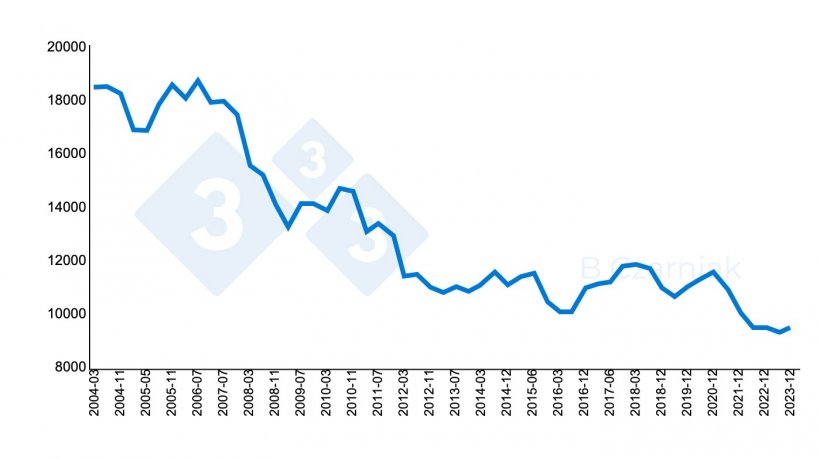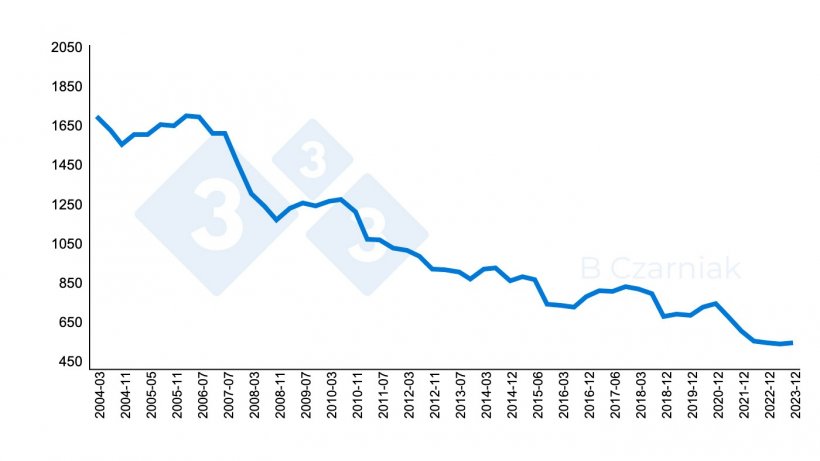For many years, swine production in Poland has faced a number of problems that have shaped its current condition. Since the early 2000s, the pig inventory has been steadily declining. Serious thought should be given to what has been the cause of this, how we can counteract it, and, above all, whether there is a chance to rebuild the country's sow inventory - the strength of a country's pig production is evidenced by how many piglets it can produce on its own for finishing, becoming independent of outside suppliers.
Let's go back to 2004 when Poland entered the EU and we were sure that our swine production would be unrivaled in terms of quality compared to the old EU countries, where the large, commercial model prevailed (except in Italy)... This was our first mistake, we thought that our pork from animals raised in a non-industrial way would defend itself with its quality. This, unfortunately, was not the case, as we were inundated with cheaply produced food, and the public quickly became accustomed to the competing cheaper products. In addition, the policy of many retail chains was mainly to emphasize “plenty and cheap.” This resulted in successive reductions in purchase prices and increasing demands on the production of feedstuffs and pork. This discouraged more farmers from sticking with farming, which had become financially insecure.



Number of sows in Poland from 2004 to 2023 (thousand head).
As you can see, the first decrease in total pig and sow numbers began in 2007, and this trend has continued. We can see the latest drastic decline in Poland's pig population in 2020, when the COVID-19 pandemic was announced, contributing to trade disruptions and lower pork consumption due to the shutdown of the hospitality industry. Despite the optimistic mood in Poland at the beginning of 2022, the country's pork production did not pick up due to Russia's invasion of Ukraine, which caused a drastic increase in the price of feed components. The situation particularly affected the number of sows in the country. Compared to 2004, it fell by nearly 70%! At the same time, the overall pig inventory fell by less than 50%. What do these figures tell us? Farmers in Poland gave up keeping sows in favor of finishing imported piglets. An important link in this model is piglets imported from Denmark, which is not irrelevant to the rest of the article.
Now that we have an understanding of the current herd situation, perhaps we should consider why farmers are not choosing to build barns for piget production. The first reason is the regulations that make it difficult to obtain a building permit for livestock facilities. Often five or more years pass between applying for zoning and receiving a building permit! During this time a lot can change in the market, starting with the farm development plan the investor chooses, through the cost of building such a facility, ending with the welfare conditions under which the new facility should be built. Another limiting factor is African swine fever (ASF), which recently marked its ten year anniversary of detection in Poland. Unfortunately, in spite of the tremendous resources and work put in by veterinarians and farmers, the virus is still spreading, making peaceful production planning impossible. The presence of the disease blocks our export opportunities to many third markets, making it impossible to diversify the income received by meat plants. Another factor hindering the industry's progress and recovery is the social factor. For some years now, the debate on intensive livestock farming has been opened in the media, questioning the welfare of animals, or the environmental impact of large commercial farms, among other aspects, giving rise to a misleading view by society of the reality on our farms.
Since we know what is causing the industry's difficulties, it is necessary to think about how to counteract this, how to use the area and human potential to make the pig herd stop declining and start gradually increasing. In the rest of the article I will present my point of view on this issue and how to go about it.
First, we need to change the regulations related to construction permits. For facilities with 150-250 livestock units, which will be operated by family farms, this path should be made as easy as possible. We need appropriate regulations such as raising the threshold for requiring an environmental report. If we allow the expansion, construction of piglet production facilities with 150-300 sows, we will allow family farms to grow. Why such sizes? Because they allow us to produce appropriately sized batches of animals while remaining family farms.
The question that arises here is why should we rely on piglet production when we import so much? After all, it has been enough for us so far... The answer is simple - the swine market situation is changing. Denmark itself is moving toward farrow-to-finish production. Danish Crown, which is the largest pig slaughtering and processing company there, is urging farmers to stop selling piglets in favor of farrow-to-finish production and putting market hogs back into their plants in exchange for additional shares in the company's profits. This is intended to ensure the supply of raw material and tie the plant permanently to the farmers - an example worth following. Since Danish farmers are being urged to abandon the piglet trade, there is a gap that needs to be filled in order to take advantage of the finishing places present in Poland. Therefore, the development of piglet production should be staked.
Another aspect is ASF. In this case, it is necessary to review the legislation. After 10 years of the disease's existence in the country, one can already confidently deduce which regulations are necessary, and which ones only create unnecessary bureaucracy that makes life difficult for farmers. In addition, measures that have a positive effect in combating and counteracting ASF should be made more effective, such as searching for carcasses and sick animals, which are a reservoir of the virus in nature, with the help of tracking dogs trained to do so. If ASF can be curbed, there is a good chance of starting trade talks with third countries on trade in pork and pork products from Poland. This will be extremely important for meat plants and the industry as a whole.
The next important point is to educate the public that pork production in the country is safe, the products are healthy, and the animals have high welfare standards to ensure their health and comfort. Foreign trade is very important, however, the strength of a sector is how much it is able to use domestically. It is also important to establish industry structures to counter false perceptions about pig farming, preventing attacks and accusations against farmers with impunity.
Poland needs a program to rebuild the pig population. Previous programs have been based mainly on financing, which has not solved the industry's problems. This resulted in successive fiascos of calls for funding. Currently, a group of industry associations and farmers is working together with the Ministry of Agriculture and Rural Development to address the barriers and create a viable development strategy for the next 10 years. Among the points to be accomplished are subsidy programs, however, they are not the primary goal. Subsidy programs, as the name suggests, are meant to aid development, not to be a panacea for the problems plaguing the industries. First of all, we need to remove barriers, so that through subsidies the farmer himself can get the benefits of breeding and raising pigs, and the state can reap the profits from taxes and the wealth of citizens.



